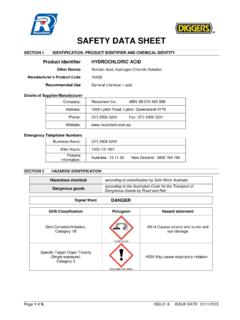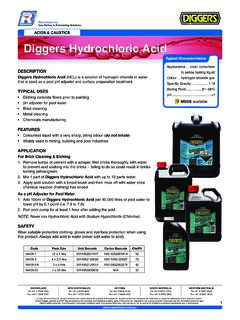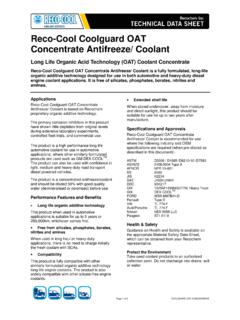Transcription of SAFETY DATA SHEET - Recochem - Australia
1 SAFETY data SHEET . SECTION 1 IDENTIFICATION: PRODUCT IDENTIFIER AND CHEMICAL IDENTITY. Product Identifier METHYLATED SPIRITS. Other Names Ethanol, Ethyl Alcohol, IMS. Manufacturer's Product Code 15000. Recommended Use Solvent, Fuel, Cleaning Solvent Details of Supplier/Manufacturer Company: Recochem Inc. ABN: 69 010 485 999. Address: 1809 Lytton Road, Lytton, Queensland 4178. Phone: (07) 3308 5200 Fax: (07) 3308 5201. Website: Emergency Telephone Numbers Business Hours: (07) 3308 5200. After Hours: 1300 131 001. Poisons Australia : 13 11 26 New Zealand: 0800 764 766. Information: SECTION 2 HAZARDS IDENTIFICATION. Hazardous chemical according to classification by Safe Work Australia according to the Australian Code for the Transport of Dangerous goods Dangerous Goods by Road and Rail Signal Word DANGER. GHS Classification Pictogram Hazard statement Flammable Liquids, H225 Highly flammable liquid and Category 2 vapour FLAME.
2 Serious Eye Damage/Irritation, H319 Causes serious eye irritation Category 2A. EXCLAMATION MARK. Page 1 of 6 ISSUE: 7 ISSUE DATE: 20/02/2017. Product: METHYLATED SPIRITS. Precautionary statements: GENERAL. P101 If medical advice is needed, have product container or label at hand P102 Keep out of reach of children P103 Read label before use PREVENTATIVE. P210 Keep away from heat/sparks/open flames/hot surfaces. - No smoking P233 Keep container tightly closed P240 Ground/bond container and receiving equipment P241 Use explosion-proof electrical/ventilation/lighting equipment P242 Use only non-sparking tools P243 Take precautionary measures against static discharge P264 Wash thoroughly after handling P280 Wear protective gloves/eye protection/face protection RESPONSE. P303 + P361 + IF ON SKIN (or hair): Take off contaminated clothing and wash before reuse. P353 Rinse skin with water/shower P305 + P351 + IF IN EYES: Rinse cautiously with water for several minutes.
3 Remove contact P338 lenses, if present and easy to do. Continue rinsing P337 + P313 If eye irritation persists: Get medical advice/attention P370 + P378 In case of fire: Use foam/water spray/fog for extinction STORAGE. P403 + P235 Store in a well-ventilated place. Keep cool DISPOSAL. P501 Dispose of contents/container in accordance with local regulations SECTION 3 COMPOSITION AND INFORMATION ON INGREDIENTS. Ingredients Names and Proportions Chemical Entity CAS Number Proportion (%). Ethanol 64-17-5 >= 95. Demin. Water 7732-18-5 <= 5. SECTION 4 FIRST AID MEASURES. Description of necessary first aid measures Remove victim from exposure if safe to do so. If rapid recovery does not Inhalation: occur, transport to nearest medical facility for additional treatment. Remove contaminated clothing. If skin contact occurs, remove contaminated clothing and wash skin Skin Contact: thoroughly with water and follow by washing with soap if available.
4 If in eyes, hold eyes open, flood with water for at least 15 minutes. If Eye Contact: symptoms persist transport to nearest medical facility for additional treatment. If swallowed, do NOT induce vomiting. Transport to nearest medical facility Ingestion: for additional treatment. Symptoms caused by exposure May cause irritation to the respiratory system. Inhalation of the vapour may Inhalation: result in drunkenness (as per effects of ingestion). Early symptoms may occur at airborne levels of 1000 to 5000ppm. May include burning sensation and/or a dried/cracked appearance. Prolonged Skin: contact may cause defatting of skin which can lead to dermatitis. Page 2 of 6 ISSUE: 7 ISSUE DATE: 20/02/2017. Product: METHYLATED SPIRITS. Eye: May include burning sensation, redness, swelling and/or blurred vision. Can cause drunkenness or harmful central nervous system effects. The deliberate ingestion of ethanol (50-100ml) may cause inebriation such that SAFETY is impaired.
5 Effects of a small intake may include excitation, euphoria, Ingestion: headache, dizziness, drowsiness, blurred vision, and fatigue. Ingestion of a large amount may lead to severe acute intoxication, tremours, convulsion, loss of consciousness, coma, respiratory arrest and death. Medical attention and special treatment Treat symptomatically. SECTION 5 FIRE FIGHTING MEASURES. Suitable extinguishing equipment Alcohol stable foam, water spray or fog. Dry chemical powder, carbon dioxide for small fires only. Do not use water in a jet. Specific hazards arising from the chemical Carbon monoxide and/or carbon dioxide may be evolved. Special protective equipment and precautions for fire fighters Wear full protective clothing and self-contained breathing apparatus. Hazchem code 2YE. SECTION 6 ACCIDENTAL RELEASE MEASURES. Personal precautions, protective equipment and emergency procedures Avoid contact with spilled or released material.
6 Shut off leaks, if possible without personal risks. Isolate hazard area and deny entry to unnecessary or unprotected personnel. Remove all sources of ignition in the surrounding area. Take precautionary measure against static discharge. Ensure electrical continuity by bonding and earthing all equipment. Environmental precautions Use appropriate containment to avoid environmental contamination. Prevent from spreading and entering waterway using sand, earth or other appropriate barriers. Attempt to disperse the vapour or to direct its flow to a safe location for example by using fog sprays. Ventilate contaminated area thoroughly. Methods and materials for containment and cleaning up For small spills (< 1 drum), transfer by mechanical means to a labelled, sealable container for product recovery or safe disposal. Allow any residues to evaporate or use an appropriate absorbent material and dispose of safely. For larger spills (> 1 drum), transfer by means such as a vacuum truck to a salvage tank for recovery or disposal.
7 Do not flush residues with water. Retain as contaminated waste. Allow any residues to evaporate or use an appropriate absorbent material and dispose of safely. SECTION 7 HANDLING AND STORAGE. Precautions for safe handling Highly flammable product. Avoid breathing vapours. Handle and open containers with care in a well- ventilated area. Ensure that the workplace is ventilated such that the Occupational Exposure limit is not exceeded. Avoid contact with skin, eyes and clothing. Wash thoroughly after handling. Do not eat, drink or smoke in contaminated areas. Electrostatic charges may be generated during transfer. Electrostatic discharge may cause fire. Ensure electrical continuity by earthing all equipment. Flameproof equipment necessary in area where chemical is being used. Vapours may accumulate in low or confined areas. Conditions for safe storage, including any incompatibilities Bulk storage tanks should be bunded.
8 Store in a well-ventilated area, away from sunlight, ignition sources and other sources of heat. Do not store near strong oxidants. Page 3 of 6 ISSUE: 7 ISSUE DATE: 20/02/2017. Product: METHYLATED SPIRITS. SECTION 8 EXPOSURE CONTROLS AND PERSONAL PROTECTION. Exposure control measures From National Occupational Health & SAFETY Commission (NOHSC) Worksafe Australia - Ethanol: 1880mg/m (1000ppm) TWA (8hr). Biological monitoring No biological limit allocated. Engineering controls Ensure that adequate ventilation is provided. Maintain air concentrations below recommended exposure standards. Avoid generating and inhaling mists and vapours. Keep containers closed when not in use. Individual protection measures Eye and face protection: Wear SAFETY goggles. Use solvent resistant gloves, nitrile for longer term protection or PVC and Skin protection: neoprene for incidental splashes. If work practices do not maintain airborne level below the exposure standard, use appropriate respiratory protection equipment.
9 When using respirators, select an appropriate combination of mask and filter. Select a Respiratory protection: filter for organic gases and vapours (boiling point > 65 C). Respirators should comply with AS1716 or an equivalent approved by a state/territory authority. Thermal hazards: Not applicable. SECTION 9 PHYSICAL AND CHEMICAL PROPERTIES. Appearance: Colourless clear liquid Odour: Alcoholic Odour threshold (ppm): data not available pH: data not available Melting point/freezing point ( C): -117. Initial boiling point and boiling range ( C): 78. Flash point ( C): 13 (Abel). Evaporation rate (Butyl acetate = 1): data not available Flammability: Highly flammable Upper/lower flammability or explosive limits (%): - Vapour pressure (mmHg @ 20 C): 44. Vapour density (air = 1, @ 15 C): Density (g/ml @ 15 C): - Solubility: data not available Partition coefficient: n-octanol/water: data not available Auto-ignition temperature ( C): 392.
10 Decomposition temperature ( C): data not available 2. Kinematic viscosity (mm /s @ 20 C): data not available Page 4 of 6 ISSUE: 7 ISSUE DATE: 20/02/2017. Product: METHYLATED SPIRITS. SECTION 10 STABILITY AND REACTIVITY. Reactivity Stable under normal conditions of use. Chemical stability Stable under normal conditions of use. Possibility of hazardous reactions Stable under normal conditions of use. Conditions to avoid Avoid heat, sparks, open flames and other ignition sources. Incompatible materials Strong oxidising agents. Hazardous decomposition products Burning can produce carbon monoxide and/or carbon dioxide. SECTION 11 TOXICOLOGICAL INFORMATION. Low toxicity in animals - Acute toxicity: LD50 Oral (rat) : 7060mg/kg LC50 Inhalation (rat, 6h) : 5900mg/m . Mild irritant. Prolonged contact may cause defatting of skin which can Skin corrosion/irritation: lead to dermatitis. Serious eye Vapours may irritate the eyes.






